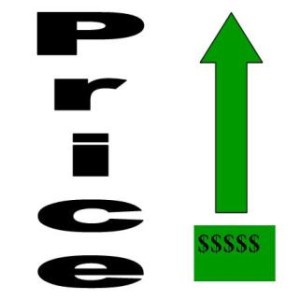 One of the toughest lessons in owning a small business is determining how much to charge for your products and services. One of the challenges is whether or not your prices are comparable to those of your competitors. Another challenge is if your customers perceive your prices to be the best value for the money. Let’s examine the first scenario; pricing your offerings according to your competition may be both good and bad. First and foremost, it’s a smart idea to remain competitive when setting your pricing. However, you do not want to be so focused on what your competitors are charging that you forget to place the appropriate value on what you offer. Your main objective should be managing the perceived value of your products and services in the mind of the consumer so that no matter what you charge, people are willing to pay it.
One of the toughest lessons in owning a small business is determining how much to charge for your products and services. One of the challenges is whether or not your prices are comparable to those of your competitors. Another challenge is if your customers perceive your prices to be the best value for the money. Let’s examine the first scenario; pricing your offerings according to your competition may be both good and bad. First and foremost, it’s a smart idea to remain competitive when setting your pricing. However, you do not want to be so focused on what your competitors are charging that you forget to place the appropriate value on what you offer. Your main objective should be managing the perceived value of your products and services in the mind of the consumer so that no matter what you charge, people are willing to pay it.
Pricing is a very complex issue no matter what type of business you are in. The complexity of determining what to charge for your products and services should be tested and retested on a consistent basis. Managing your client’s expectations around price can be tricky. If you find that you consistently have back orders for a particular product, then it may be time to raise the price. If you have a long waiting list for a particular service that you offer, it may be time to raise the price.
Before you get nervous about the concept of increasing rates and raising prices, allow me to caution you that you can absolutely do both, and keep your customers. Below I’ve listed a few tips for you to consider when you want to raise your prices and keep your customers in tow.
- Get Out of Your Own Way – I know this may sound obvious but in many cases it isn’t. Many times as business owners, we hesitate to raise prices for fear that we will lose customers. So we allow fear to keep us stuck providing a product or service at a rate that doesn’t provide a profit. Many times a limiting belief held in our mindset is the reason why we don’t charge what something is worth. Decide now that you will reevaluate your pricing and get what you deserve. You’re the boss and that simply means if you say it’s a certain price, that’s what it is. It’s important to test and measure what works and what doesn’t. Remember to always ask for customer feedback. If your customers believe that the price was worth the investment, that’s a good indication that you’re on the right track.
- Prepare Existing Clients for the Price Increase – Most people don’t like to be unpleasantly surprised that a price has increased without proper notification. However, if you communicate with your clients to expect a price increase within the next 30 to 60 days they have time to plan and budget for the increase. However, if you decide to raise prices with no warning, you might get angry customers who discontinue using your products or services. Having a simple conversation with your clients or notifying them in writing via email or direct mail are all great ways for keeping your clients aware of impending price increases. Once you explain the reason for the increase and notify your clients it is coming, you are more likely to them to renew and continue doing business with your company.
- Plan Your Profit Margins – Always make certain to plan your profit before you set the price on any item. Your profit calculated as the amount of money you make after expenses are deducted from the total retail price. Your job is to research ways to minimize your costs, increase your rates and thereby increase your profit margins. Of course you must examine the quality and perceived value of the product or service you are offering before you raise or increase prices. If the demand is there, by all means you have a strong indication that it may be time for a rate increase.
- Offer Price Variances – Setting prices that range from high to low means that there is something for everyone. Be certain to offer products and services at price points that meet your ideal client’s profile. If your ideal clients are doctors and attorneys the pricing should reflect the value of the item being sold as well as who you are selling it to. By the same token if your ideal clients are retired seniors, likewise your pricing should be in alignment with what that audience typically would respond to. The key is to know your target customer and what they will and will not pay for or find valuable.
Finally, if you’re at a point in your business where it is time to evaluate or change your pricing structure, you may begin by analyzing the quality of your product or service. Ask yourself, is this something I would pay for? If the answer is yes, then you have a good indication. If the answer is no, well it might be time to make adjustment in the product or service to create more value.
The bottom line is that your pricing should be structure should help you realize a profit. However, you must always offer value, convenience and customer service to keep your customers coming back for more.
© 2014 Quality Media Consultant Group, LLC – All Rights Reserved
This article is written by Lori A. Manns. Want to use this article for your website, blog or newsletter? No problem. Here’s what you must include: Lori A. Manns, CEO of Quality Media Consultant Group and a master marketing and sales coach as well as business strategist. Lori is founder of Traiblazer Business Academy™ where entrepreneurs go to learn trailblazing business solutions and the Sponsorship Sales Secrets System;™ that shows you how to get more sponsors and sales for your business, guaranteed. To secure consulting services on marketing, advertising or sales and learn how to increase your revenue and grow your business; complete a form on the contact us page via www.qualitymediaconsultants.com.
